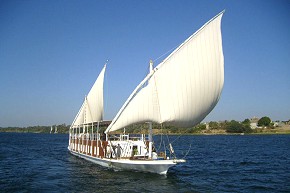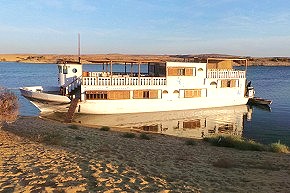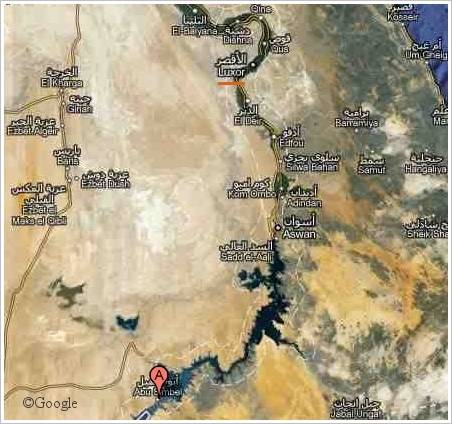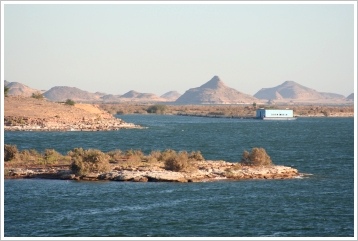We Provide
- Building Land
- Gabawi *1712 (350 sqm)
- Gorf *2105 (525 sqm)
- Gorf *2206 (700 sqm)
- Aqalta *2207 (1,050 sqm)
- House Building Service
- Architecture
- Real Estates
- Villa Hana, Ramla
- Shell Apartment Papyrus, Habu
- Apartment Hatshepsut 2, Gezira
- Apartment Hatshepsut 3, Gezira
- Apartment Hatshepsut 4, Gezira
- Holiday Flats
- Hatshepsut 1 (1 BR), Gezira
- Hatshepsut 2 (1 BR), Gezira
- Nile View (1 BR), Ramla
- Hatshepsut 3 (2 BR), Gezira
- Hatshepsut 4 (2 BR), Gezira
- Hatshepsut 5 (2 BR), Gezira
- Hatshepsut 7 (2 BR), Gezira
- Hatshepsut 9 (2 BR), Gezira
We Organise
We Report
- Sorry, no more news!
- News 2014 (26)
- News 2013 (76)
- News 2012 (92)
- News 2011 (125)
- News 2010 (31)
- News 2009 (12)
- News Overview
Useful Tools
Dahabiya Nile Cruises• from Esna to Aswan |
Lake Nasser Cruises• from Aswan or Abu Simbel |
![]()
Living in Luxor - Excursions: Trips from Luxor to Abu Simbel
![]()
 When you mouse over a picture you will get a description and copyright information. Unless otherwise specified copyright is reserved by Living in Luxor. External links are marked with
When you mouse over a picture you will get a description and copyright information. Unless otherwise specified copyright is reserved by Living in Luxor. External links are marked with ![]() .
.
![]()
Abu Simbel is famous for its two rock-cut temples, which were threatened to lie on the ground of Lake Nasser.
Journey to Abu Simbel
By boat: We offer cruises on the Lake Nasser, which happen from Aswan to Abu Simbel or vice versa. It's an amazing experience to see the temples of Abu Simbel rise on the horizont! Also, you visit all the Nubian temples that are only accessible by boat.
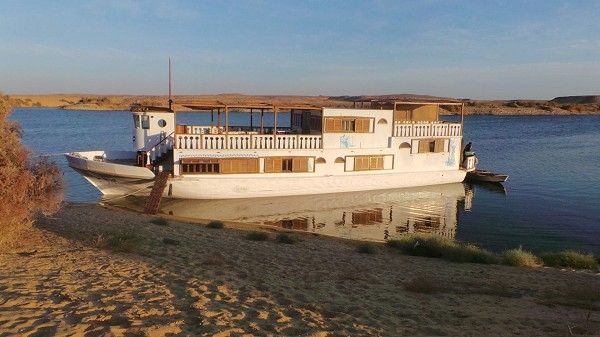
Safari boat on Lake Nasser
By plane: For swiftly travelling people with deep pockets. A flight from Aswan to Abu Simbel takes 45 minutes (there is no direct flight from Luxor!). Abu Simbel Airport (ABS) is situated ca. 4 km away from the temples.
By car/minibus: Coming from Aswan, which is about 240 km away, foreign travellers can get to Abu Simbel only travelling in police convoys. There is at least one daily convoy each way, taking 3 - 4 hours. But you are free to go from Luxor to Aswan whenever you want. It's worthwhile to allow yourself plenty of time in order to visit en route the Temple of Khnum at Esna, the Temple of Horus at Edfu and the Dual Temples of Sobek and Haroeris at Kom Ombo.
If you didn't choose to visit Abu Simbel by a Lake Nasser cruise or by plane, there are two variants conceivable for your journey from Luxor to Abu Simbel by car (about 540 km):
Variant 1:
Day 1: Jouney from Luxor to Aswan with en-route visit of the temples at Edfu and Kom Ombo, overnight stay in Aswan
Day 2: Very, very early continuation of your journey to Abu Simbel, visit of the temples at Abu Simbel and return jouney to LuxorVariant 2:
Day 1: Journey from Luxor via Aswan to Abu Simbel, overnight stay in Abu Simbel
Day 2: Visit of the temples at Abu Simbel, return jouney to Luxor with en route visit of the temples at Kom Ombo and Edfu
Route from Luxor to Abu Simbel (A), © Google
Kindly let us know your wishes, we make you a favourable offer.
![]()
The Rock Temples at Abu Simbel
Abu Simbel temples are two massive rock temples in Nubia, southern Egypt on the western bank of Lake Nasser about 300 km southwest of Aswan. The complex is part of the UNESCO World Heritage List. The twin temples were originally carved out of the mountainside during the reign of Pharaoh Ramses II in the 13th century BC, as a lasting monument to himself and his queen Nefertari, to commemorate his alleged victory at the battle of Kadesh, and to intimidate his Nubian neighbors. However, the complex was relocated in its entirety in 1968, on an artificial hill made from a domed structure, high above the Aswan High Dam reservoir to avoid its being submerged during the creation of Lake Nasser. Nevertheless, Abu Simbel remains one of Egypt's top tourist attractions.

Great (on the left) and Small Temple (on the right) at Abu Simbel
Great Temple at Abu Simbel
It is believed that the axis of the temple was positioned by the ancient Egyptian architects in such a way that biyearly, the rays of the sun would penetrate the sanctuary and illuminate the sculptures on the back wall, except for the statue of Ptah, the god connected with the Underworld who always remained in the dark. After the relocation of the temple the solar phenomena still work. Nowadays, it is occurring on October 22 and February 20.
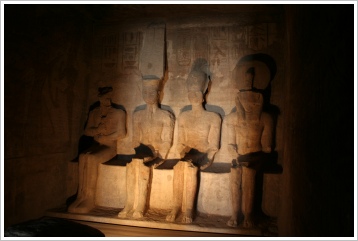
Great Temple at Abu Simbel - Sanctuary
Four colossal 22 m statues representing pharao Ramses II decorate the facade of the temple which is 38 meters wide. The statue to the left of the entrance was damaged in an earthquake, leaving only the lower part of the statue intact. The head and torso can still be seen at the statue's feet. The entrance itself is crowned by a bas-relief representing two images of the king worshiping the falcon-headed Ra-Harakhti. The hypostyle hall is 18 m long, has eight side chambers, and is supported by eight huge Osiris pillars. From the hypostyle hall one enters the second pillared hall which gives access to a transverse vestibule in the middle which is again the entrance to the sanctuary.
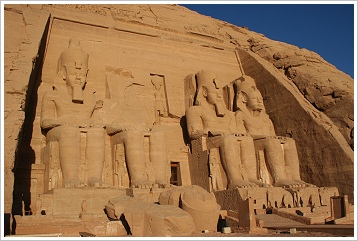
Facade of the Great Temple at Abu Simbel
Small Temple at Abū Sinbel
The Small Temple was built about one hundred meters northeast of the Great Temple of Ramses II and is dedicated to the goddess Hathor and Ramses' II beloved Great Royal Wife Nefertari. The rock-cut facade is decorated with two groups of 10 m high colossi representing the queen and the king. The plan of the Small Temple is a simplified version of that of the Great Temple with hypostyle hall, Hathor pillars, vestibule, and sanctuary.
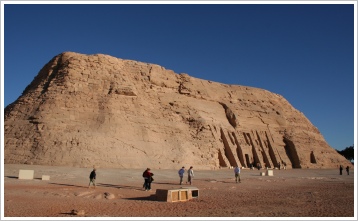
Small Temple at Abu Simbel
Tips for a Visit of Abu Simbel
The temples are sun-drenched only before noon, that's why the most tourists arrive in the very early morning. It may be true that both temple facades are in the realm of shades in the afternoon hours but, then, it's a calmer place for strolling. So, if time permits you should stay the whole day and enjoy the wonderful view overlooking the Lake Nasser, too.
Triply in the evening an impressive Sound & Light Show will transport visitors to the time of the pharaohs. The program is presented in a number of languages (English, French, German, Italian, Spanish, Russian, Japanese, Arabic) with the provision of ear pieces.
![]()
Temple of Horus at Edfu
The Temple at Edfu is located some 85 km south of Luxor on the west bank of the Nile and is the second largest temple in Egypt after Karnak and one of the best preserved. Dedicated to the falcon god Horus, it was built in the Ptolemaic period between 237 and 57 BCE and was the center of several festivals sacred to Horus. Each year, Hathor travelled south from her temple at Dendera to visit Horus at Edfu, and this event marking their sacred marriage was the occasion of a great festival and pilgrimage. The remains of the ancient settlement of Edfu are situated about 50 m to the west of the Ptolemaic temple.
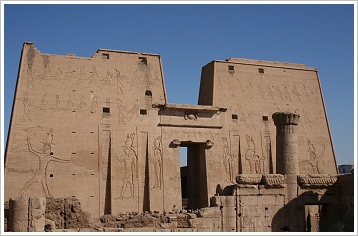
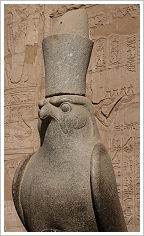
Temple of Horus at Edfu and statue of falcon god Horus
Temple of Sobek and Haroeris at Kom Ombo
Kom Ombo is situated 150 km south of Luxor. The dual temples stand upon the top of a sandy hill on the east bank of the Nile, and appear to have been a species of Pantheon. The left temple is dedicated to the crocodile-headed god Sobek, the right one in honour of the falcon god Haroeris. At this site there is a nilometer used to measure the level of the Nile river waters and a small chapel of Hathor with a mummy of a sacred crocodile.
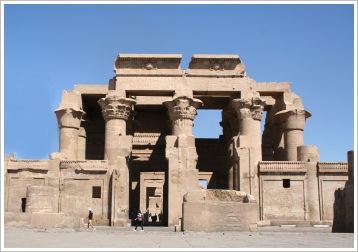
Temple of Sobek and Haroeris at Kom Ombo
![]()
Our Service in Luxor
We organise your trip to Abu Simbel. Kindly let us know your wishes, we make you a favourable offer.
![]()
![]()
Travel Preparation
 |
The Mysteries of Abu Simbel: Ramses II and the Temples of the Rising Sun ~
Zahi A. Hawass £12.56 |
![]()
 To the list of excursions ...
To the list of excursions ...
